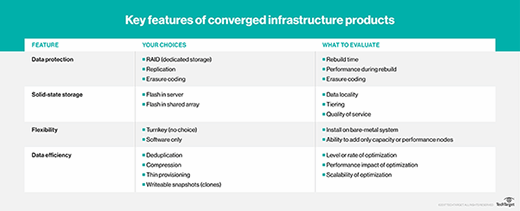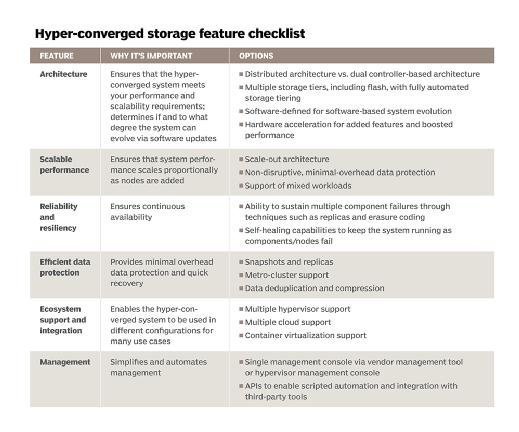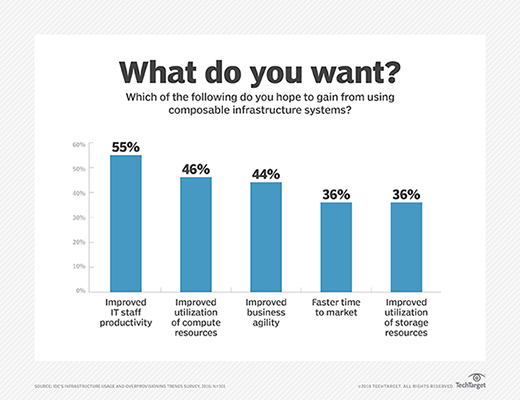
WavebreakMediaMicro - Fotolia
Composable architecture options versus CI and HCI
While converged, hyper-converged and composable infrastructures all share some degree of similarity in convergence, important differences can affect your IT architecture choices.
There are now three clear types of IT architectures based on the principles of technology convergence: converged infrastructure, hyper-converged infrastructure and composable infrastructure, also known as composable architecture.
The goal of all three infrastructures is to deliver compute, storage and network resources as efficiently and easily as possible, while ensuring optimization for specific workloads. However, the way they achieve this goal varies significantly from one infrastructure to the next.
Hardware designed to work together: Converged infrastructure
Converged infrastructure (CI) takes a hardware-centric approach to delivering resources. A CI is an integrated, preconfigured bundle highly optimized for its identified workloads. A CI consists of the traditional parts of a storage network -- arrays, servers, network connectivity and virtualization -- racked and stacked by the vendor making the sale. For example, Cisco is a common CI partner of storage vendors, including its servers and switching with arrays. The pieces often come from different vendors, which usually have reference architectures that recommend bundles based on applications, users, performance needs and other characteristics.
The converged infrastructure approach can reduce administrative overhead, but customers often pay extra for the convenience of having the system bundled before purchase.

A CI implementation eliminates many of the complexities that come with deploying and managing a traditional storage system. It reduces hardware incompatibilities and implements a modular architecture that utilizes blocks of predictable hardware resources. This modular structure makes it easier to scale systems, while providing discrete components that can be used independently of the larger converged infrastructure platform.
Virtualizing resources via a hypervisor: Hyper-converged infrastructure
Unlike a converged system, hyper-converged infrastructure (HCI) takes a software-centric approach to delivering compute, storage and network resources in preconfigured server nodes. Although both infrastructures use virtualization technologies, an HCI system does so to a much greater degree through its tight integration with hypervisor software.
A hyper-converged infrastructure platform uses virtual machines (VMs) or containers to abstract the hardware resources and to run specialized software that aggregates the resources into logical resource pools that can be easily managed and allocated to accommodate any necessary workloads.
An HCI system is made up of multiple nodes, usually at least three, and users can build one based on commodity hardware. Each node is a physical server with its own directly attached storage. The software-driven architecture abstracts the server resources into logical groups to create what is essentially a hardware-agnostic platform. That's a different approach than a converged infrastructure system, which uses hardware that has been engineered and validated to work together.

HCI's software-centric approach also makes the infrastructure more flexible when it comes to accommodating changing workloads. Altering the configuration of a converged infrastructure is much more difficult after it's been implemented. In addition, because a hyper-converged infrastructure relies on virtualization technologies, the structure can lead to better resource utilization than a CI platform, although this isn't always the case.
To scale an HCI system, administrators only need to add nodes. However, this also means compute, storage and network resources scale as a single unit, which can lead to overprovisioning of some resources to meet the needs of another. HCI vendors have become more flexible in this area, but overprovisioning can still be an issue. In addition, because a hyper-converged infrastructure is so highly integrated, the components cannot be used independently of each other, like they can with a converged infrastructure offering.
The best of both worlds? Composable architecture
Composable architecture delivers the compute, storage and network resources as services based on logical resource pools, similar to HCI. However, it can be implemented on bare metal, in VMs or within containers, and the physical resources can run in any location, rather than having to be consolidated within a couple of integrated racks. As a result, composable architecture can offer greater flexibility than either a converged or hyper-converged infrastructure system.
Composable architecture uses software-defined technologies to pool physical resources, which can be based on commodity hardware, much like an HCI implementation. However, the composable infrastructure takes it up a notch by enabling IT administrators to provision resources on demand to accommodate changing workloads. This is achieved by exposing them as objects that can be activated, or composed, through API calls that work in conjunction with the infrastructure's intelligent software. For example, a developer can define an application's resource requirements by using policies and service profiles that, in turn, make API calls to compose the necessary infrastructure.

For the most part, composable architecture promises greater flexibility, more granular scalability and better resource utilization than either converged infrastructure or hyper-converged infrastructure. However, the technologies behind composable infrastructure are still relatively new when compared to the others. That said, there's currently a fair amount of interest in composable architecture and the software-defined data center in general.








